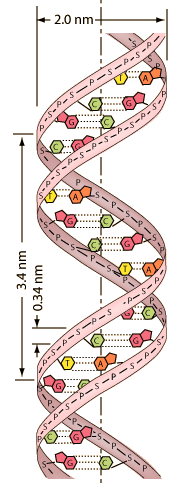This is a depiction of the famous double helix patterned after Karp's presentation. That of Audesirk & Audesirk is similar.The color coding emphasizes the role of the four distinct nitrogenous bases adenine, thymine, guanine and cytosine. |  |
At right above is a depiction of a section of the sugar-phosphate backbone of DNA which conforms into one strand of the double helix. The bases may be attached in any order, and this gives the vast number of possibilities of arrangements which are possible in the genetic code. In the double helix, bases are only attached by hydrogen bonds to their complementary base, that is A-T and G-C. This arrangement makes possible the separation of the strands and the replication of the DNA double helix.
A remarkable feature of DNA structure is that the message written in the alphabet of the four bases is written in a true code - that is, the order of the bases is not determined by the chemistry and physics any more than the order of words in a written book is determined by the physics and chemistry of the ink and paper.
One thing that these sketches do not show is that the
planes of the bases are essentially perpendicular to the axis of the helix.


